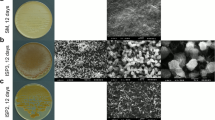Abstract
Actinoplanes teichomyceticus produces the lipoglycopeptide antibiotic teicoplanin, which is considered a last line of defense against multidrug resistant Gram-positive cocci. Different strategies have been employed to generate industrial producers of teicoplanin, however they do not include manipulations of teicoplanin biosynthetic genes due to a poorly developed genetic “toolkit” for this strain. Through this work, we extend the choice of vectors that can be conjugally transferred and maintained in A. teichomyceticus. Antibiotic producing properties and stability of the transconjugants have been examined. As an illustration of the utility of pSG5-based vector pKC1139, we improved teicoplanin production by the wild type strain via manipulations of two regulatory genes from the teicoplanin biosynthetic cluster, tcp28 and tcp29.


Similar content being viewed by others
References
Bardone MR, Paternoster M, Coronelli C (1978) Teichomycins, new antibiotics from Actinoplanes teichomyceticus-Nov-sp. 2. Extraction and chemical characterization. J Antibiot 31:170–177
Gregory MA, Till R, Smith MC (2003) Integration site for Streptomyces phage phiBT1and development of site-specific integrating vectors. J Bacteriol 185:5320–5323
Guo J, Zhao J, Li L, Chen Z, Wen Y, Li J (2010) The pathway-specific regulator AveR from Streptomyces avermitilis positively regulates avermectin production while it negatively affects oligomycin biosynthesis. Mol Genet Genomics 283:123–133
Ha HS, Hwang YI, Choi SU (2008) Application of conjugation using phiC31 att/int system for Actinoplanes teichomyceticus, a producer of teicoplanin. Biotechnol Lett 30:1233–1238
Horbal L, Rebets Y, Rabyk M, Luzhetskyy A, Ostash B, Welle E, Nakamura T, Fedorenko V, Bechthold A (2010) Characterization and analysis of the regulatory network involved in control of lipomycin biosynthesis in Streptomyces aureofaciens Tü117. Appl Microbiol Biotechnol 85:1069–1079
Jung H-M, Jeva M, Kim S-Y, Moon H-J, Singh RK, Zhang Y-W, Lee J-K (2009) Biosynthesis, biotechnological production, and application of teicoplanin: current state and perspectives. Appl Microbiol Biotechnol 84:417–428
Kieser T, Hopwood DA, Wright HM, Thompson CJ (1982) pIJ101, a multi-copy broad host-range Streptomyces plasmid: functional analysis and development of DNA cloning vectors. Mol Gen Genet 185:223–228
Kieser T, Bibb MJ, Buttner MJ, Chater KF, Hopwood DA (2000) Practical Streptomyces genetics. John Innes Foundation, Norwich, United Kingdom
Li TLHF, Haydock SF, Mironenko T, Leadlay PF, Spencer JB (2004) Biosynthetic gene cluster of the glycopeptide antibiotic teicoplanin: characterization of two glycosyltransferase and the key acyltransferase. Chem Biol 11:107–119
Luzhetskii AN, Ostash BE, Fedorenko VA (2001) Interspecies conjugation of Escherichia coli–Streptomyces globisporus 1912 using integrative plasmid pSET152 and its derivatives. Genetika 37:1340–1347
Luzhetskyy A, Fedoryshyn M, Gromyko O, Ostash B, Rebets Y, Bechthold A, Fedorenko V (2006) IncP plasmids are most effective in mediating conjugation between Escherichia coli and Streptomycetes. Rus J Genet 42:476–481
Menges R, Muth G, Wohlleben W, Stegmann E (2007) The ABC transporter Tba of Amycolatopsis balhimycina is required for efficient export of the glycopeptide antibiotic balhimycin. Appl Microbiol Biotechnol 77:125–134
Ostash B, Rix U, Rix LL, Liu T, Lombo F, Luzhetskyy A, Gromyko O, Wang C, Brana AF, Mendez C, Salas JA, Fedorenko V, Rohr J (2004) Generation of new landomycins by combinatorial biosynthetic manipulation of the LndGT4 gene of the landomycin E cluster in S. globisporus. Chem Biol 11:547–555
Ostash B, Doud E, Ostash I, Lin C, Fuse S, Perlstein D, Walker S (2009) Complete characterization of the seventeen-step moenomycin biosynthetic pathway. Biochemistry 48:8830–8841
Sambrook J, Russell DW (2001) Molecular cloning, a laboratory manual, 3rd edn. Cold Spring Harbor Laboratory Press, New-York
Seco EM, Cuesta T, Fotso S, Laatsch H, Malpartida F (2005) Two polyene amides produced by genetically modified Streptomyces diastaticus var. 108. Chem Biol 12:535–543
Somma S, Gastaldo L, Corti A (1984) Teicoplanin, a new antibiotic from Actinoplanes teichomyceticus nov. sp. Antimicrob Agents Chemother 26:917–923
Soo PC, Horng YT, Lai MJ, Wei JR, Hsieh SC, Chang YL, Tsai YH, Lai HC (2007) Pirin regulates pyruvate catabolism by interacting with the pyruvate dehydrogenase E1 subunit and modulating pyruvate dehydrogenase activity. J Bacteriol 189:109–118
Sosio M, Kloosterman H, Bianchi A, de Vreugd P, Dijkhuizen L, Donadio S (2004) Organization of the teicoplanin gene cluster in Actinoplanes teichomyceticus. Microbiology 150:95–102
Truman AW et al (2008) The role of cep15 in the biosynthesis of chloroeremomycin: reactivation of an ancestral catalytic function. Chem Biol 15:476–484
Vobis G (2006) The genus Actinoplanes and related genera. Prokaryotes 3:623–653
Voeykova T, Emelyanova L, Tabakov V, Mkrtumyan N (1998) Transfer of plasmid pTO1 from Escherichia coli to various representatives of the order Actinomycetales by intergeneric conjugation. FEMS Microbiol Lett 162:47–52
Wagner N, Osswald C, Biener R, Schwartz D (2009) Comparative analysis of transcriptional activities of heterologous promoters in the rare actinomycete Actinoplanes friuliensis. J Biotechnol 142:200–204
Zotchev S, Haugan K, Sekurova O, Sletta H, Ellingsen TE, Valla S (2000) Identification of a gene cluster for antibacterial polyketide-derived antibiotic biosynthesis in the nystatin producer Streptomyces noursei ATCC 11455. Microbiology 146:611–619
Acknowledgments
This work was supported by grants from the Ministry of Education and Science of Ukraine and National Academy of Sciences of Ukraine (to Victor Fedorenko and Sergiy Shugla). John P. Santa Maria (Harvard Medical School) is thanked for careful reading of the manuscript.
Author information
Authors and Affiliations
Corresponding author
Additional information
Lilia Horbal and Nestor Zaburannyy contributed equally to the main findings of the work.
Electronic supplementary material
Below is the link to the electronic supplementary material.
Rights and permissions
About this article
Cite this article
Horbal, L., Zaburannyy, N., Ostash, B. et al. Manipulating the regulatory genes for teicoplanin production in Actinoplanes teichomyceticus . World J Microbiol Biotechnol 28, 2095–2100 (2012). https://doi.org/10.1007/s11274-012-1013-6
Received:
Accepted:
Published:
Issue Date:
DOI: https://doi.org/10.1007/s11274-012-1013-6




